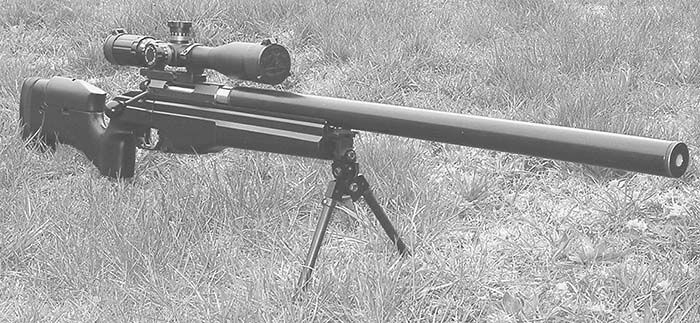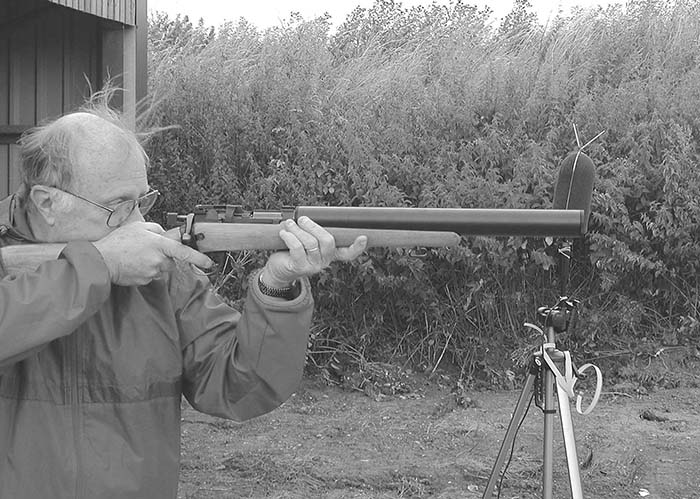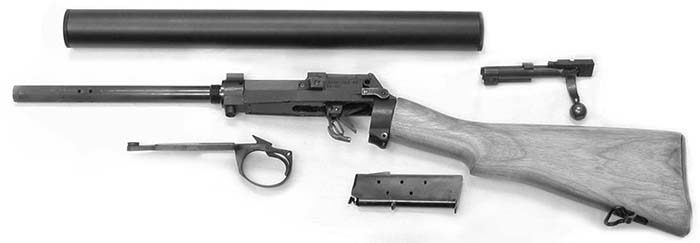LEI’s new M4-QD high efficiency, compact suppressor in caliber 5.56mm NATO on the Colt M4 carbine. Mounting is by means of the LEI Universal Mount, which attaches to any 22mm NATO specification flash hider. (Photo courtesy LEI)
Philip H. Dater, MD
London, located in southeast England, is one of the larger cities in the world and it is the largest in Europe. The village of St. Albans, nestled on the northwest outskirts of London, is one of the oldest towns in England- dating back to the Roman occupation of Brittany. Just outside of St. Albans in a non-descript and unmarked building on six acres is Law Enforcement International, Ltd.
Gregory Felton, a young innovator and entrepreneur with a “can-do” attitude, founded Law Enforcement International, Ltd in 1987. While the primary focus has been the design, manufacture, and sale of sound suppressors, LEI has manufactured custom exotic firearms and accessories for special clients. LEI products have been exported to well over forty countries, including a number of NATO members. Many of their products have NATO stock numbers.
In addition to suppressors, the company is involved in the supply, procurement, and brokering of ammunition, weapons, and accessories for military and police clients worldwide. The company maintains a modest collection of weapons for reference and for suppressor development. Under current British law, many weapons are difficult to own, and LEI is one of the few Section 5 firearm dealers in the United Kingdom. The Section 5 license is comparable to the Class 2 and Class 3 firearm dealer in the United States.

Unlike the United States where silencers are highly restricted, regulated, and taxed items, in the United Kingdom they are treated just like any standard firearm and are considered accessories. Police freely issue licenses for civilian possession of silencers just as they do for rifles and shotguns for the purpose of hunting small game and vermin control. Like many European countries, silencers are considered primarily a noise abatement and hearing protection item and are considered to be courteous and “neighborly.”
The initial focus of the company was the design and production of silencers with military and law enforcement agencies as the desired market. As with many fledgling companies attempting to break into this market, many were sold into the civilian community competing with designs such as the Parker-Hale or Unique. The first LEI suppressors were designed for sporting arms in calibers .223 and .308. These units were relatively large (by today’s standards, but no larger than comparable USA units of the time) and used a straightforward conical baffle stack. These suppressors had the advantage of relative simplicity and economical manufacturing.
Integral suppressor development at LEI started in 1989. The first was a reproduction of the DeLisle carbine and was followed by manufacture and sale of integrally suppressed Ruger pistols and rifles. Since the UK total ban on civilian ownership of handguns, the integral Ruger pistol is now only available for the export market, although integrally suppressed Ruger 10/22 and 77/22 rifles remain available. The primary impetus for the integral .22LR weapons was to eliminate the need to find subsonic ammunition. The integral .22 suppressed rifles are still offered today on a limited, time available basis. Rather than the Ruger rifle, the current host weapon of choice is the outstanding Sako .22LR Finnfire rifle.
The DeLisle was produced by a number of companies during World War II, including Sterling Armament Co. In 1987, Giles Whittome, who was the managing director of Sterling Armament Company at the time, collaborated with LEI to produce a prototype of the MK-2 DeLisle (only one was made). By agreement with Sterling, LEI registered the trademark and began manufacturing an improved version of the DeLisle, the MK-3, which remained in full production and commercially available until 1990. In response to demand, another production run was made of this fine weapon from 1999 through 2001. Production has now ceased, and the weapon is no longer available.

LEI silencers have been widely distributed and well received in the European military and police market as well as in a number of Far- and Mid-Eastern countries. The mainstay products have been rifle suppressors for .223 and .308 weapons, suppressors for the 9mm H&K MP5, a suppressor utilizing a recoil enhancer (similar to the Neilsen device) for 9mm handguns, and the integrally suppressed Sako TRG-22 .308 sniper rifle, designed TRG-SPP by LEI. Many of the suppressors have NATO stock numbers, and LEI is a NATO codified contractor. Currently, LEI has three major divisions: UK, Government Contract, and Manufacturing. The focus of the UK division is supplying ammunition to law enforcement agencies, primarily in the United Kingdom. LEI is the exclusive agent in the UK for Israeli Military Industries ammunition, and ammunition sales run several million rounds a year.
The direction of the Government Contract division is the sale of weapons, accessories, and ammunition to governments and military units, both NATO and other countries friendly to the United Kingdom. Import restrictions imposed by the United States Department of State make sales to the US government impractical, and US Department of State export restrictions make sales of silencers to friendly foreign governments essentially impossible, widely opening the market for European based companies such as LEI. Export from the United Kingdom to friendly nations is markedly simpler than it is from the United States.
The manufacturing division designs and manufactures silencers. LEI has maintained a good working relationship with the UK division of Heckler & Koch, and MP5 submachine guns manufactured in the UK at Nottingham were supplied only with LEI suppressors. The first military contract LEI received was for suppressors for the MP5 and for the M16 rifle and for use in the 1991 Gulf War in 1991.
LEI has built a wide variety of silencers, but the flagship suppressed weapons have been the suppressed SAKO TRG-22 sniper rifle and muzzle suppressors for .223 and .308 rifles.

The SAKO TRG-22 was designed from the start as a suppressed sniper rifle. Starting with a SAKO action and stock, the weapon system was built up with a 14.5-inch fast twist stainless steel match barrel optimized for the Lapua subsonic .308 ammunition loaded with the 200-grain projectile. To this are fitted precision optics and a suppressor completely enclosing the barrel. The optics feature quick detach mounting, which enables the rapid change from conventional to night vision optics. With this combination, group sizes of 1/2 inch at 100 meters are standard with no appreciable sound discernable more than a few meters from the shooter. Maximum range of this weapon is 200-250 meters with subsonic ammunition. At the 1999 Finnish trials, the muzzle velocity was measured at 300 m/s using Lapua 200 grain subsonic ammunition and delivering an absolute sound level of 122 dB one meter to the left of the muzzle. When using conventional 7.62×51 NATO ball ammunition with a muzzle velocity of 897 m/s, the sound pressure level is unchanged at 122 dB, although a ballistic crack is present from the supersonic projectile. The author had an opportunity to measure the sound levels of this weapon using the Lapua 200 grain ammunition on a dismally drizzly day in July 2001 and found the absolute sound pressure level to be 124 dB. There is known to be day-to-day variation, and this is within normal fluctuation. This weapon has seen extensive use by both military and police in hostage rescue situations.

The majority of suppressors, however, are for military rifles in both 5.56mm NATO (the M16 and SA-80) and in 7.62 NATO. Military end users are almost universally unwilling to remove a flash hider to thread on a suppressor, much less change to a proprietary flash hider/mount. In 1990, Greg Felton invented and patented a no-tools mount to attach the LEI suppressors to a standard NATO specification 22mm flash hider. While this mount, referred to as the “Universal” mount, is not the instant-on mount normally associated in the USA with the term “Quick Detach,” it can be installed in less than 30 seconds without tools and the mounting is both secure and will not unscrew. The design was patented both in the UK and in France. This mount has been licensed to at least one manufacturer abroad.
The original .223 and .308 suppressors were moderately large, measuring 45 mm in diameter and 350 mm in length (1.75 x 13.75 inches) including the Universal mount. The baffles were a conventional Maxim type. Although sound reduction was measured at the 1999 Finnish trials as 37 dB, the manufacturer claims 35 dB reduction on a standard M4 carbine. On the same dismal day when the author measured the SAKO TRG-22, the Universal suppressor delivered a solid 32.8 dB reduction on an M4 carbine with SS-109 ammunition. The Commando, a shorter version of the Universal suppressor, has also been available. The Commando measures three inches shorter than the Universal and delivers slightly reduced performance (29 dB).
Suppressor designs have been continually evolving on both sides of the Atlantic Ocean, stressing more compact and lighter weight products that maintain the same or even greater efficiency than their older and larger counterparts. Unfortunately, the designs and alloys used increase the production costs significantly. LEI’s research and development has developed advanced and efficient 5.56mm suppressor designs using titanium alloys and radical new baffle designs. However, due to the increased cost and most military client inexperience, these designs were “put on ice.” After all, a suppressor is a suppressor, so buy the cheapest! Fortunately, times are changing, clients are more educated, and end users realize the value of smaller and more efficient units. Considering the advantages, the cost is not as much of a barrier.

The QD-16 family of suppressors for the NATO 5.56×45 cartridge is the first of a number of the new designs. Utilizing the Universal mount, the entire suppressor (including the mount) is only 40 mm diameter, 220 mm long (1.5 by 8.6 inches) and weighs 750 grams (26 oz). It features a complex baffle stack manufactured from a titanium-niobium super-alloy. While utilizing half the volume of the original Universal suppressor, the QD-16 in 5.56mm maintains similar sound reduction (33 dB on the M4 carbine). Testing has shown no deleterious effect on accuracy, and the suppressor will withstand fully automatic fire (subject to the limitations of the ammunition and host firearm). The QD-16 suppressor is proving popular for the M4 family of weapons with significant interest in the UK and other European countries. Because it mounts on a NATO standard flash hider, it also fits the SA-80, FAMAS, HK33, and HK G36. Under development is a 3 cm shorter variant of the QD-16 with a reduction of approximately 31 dB.
The UK police are gradually moving from 9mm carbines to compact weapons in 5.56mm caliber, primarily the HK G36C and G36K. As a result, there is an increasing utilization of suppressors by the agencies. Police-owned suppressors are used for training rather than operational purposes, primarily for control of noise pollution on ranges (often indoors) and for hearing protection. The Health and Safety at Work legislation is taken seriously, as the agencies do not wish to have to defend hearing loss claims in court. The QD-16 family of suppressors is ideal. Next, the agencies need to learn the true value of suppressors on operational missions!
Handguns are now “prohibited weapons” in the UK, eliminating the civilian market for handgun suppressors. Available to law enforcement is a miniscule 9mm suppressor for the Beretta 92 (also works with SIG, CZ and other Colt-Browning mechanisms). Designated the model SQ, this suppressor consists of two 1-1/8 inch diameter tubes (one above the other) measuring 4-3/4 inches long. The bore aperture is through the upper tube (which contains four wipes), while the lower tube functions as a pressure dump. The Finnish 1999 trials measured the reduction at 23 dB, and the author reproduced this figure in 2001.
Although the primary focus has been on suppressors for the military and law enforcement, the civilian market has not been neglected. The traditional nomenclature for sound suppressors in the civilian market are “sound moderators.” LEI manufactures a wide variety of moderators for sporting rifles in calibers .17 through .45. Muzzle suppressors for .22LR rifles are available from LEI, and while they compete favorably with the Parker-Hale in size, they are more efficient.
LEI has a Larson-Davis 800B sound meter with the correct 1/4 inch instrumentation microphone and performs all sound measurements as per requirements set forth in MIL-STD-1474D. Sound measuring in the UK is not particularly easy. In the USA, one often goes to a local range, open land controlled by the BLM, or (if lucky) one’s back yard. The process of finding a place to shoot in the UK is overburdened with regulatory requirements. First, one needs to find an approved and registered range (the construction of which is specified in nauseating detail). Next, one has to make an appointment with the owner for a private session, as other shooters will make sound measurements almost impossible. Running up a flag, posting warning signs about a hot range in all directions (including on the road), and carefully logging each and every round expended completes the process. It takes a lot of dedication to conduct a range measuring day.
Law Enforcement International, Ltd. is a growing force in the international suppressor market. Unfortunately, due to US laws, their products are not importable for civilian sales in the USA.
Law enforcement International and Greg Felton can be contacted by fax at (+44)-1727-826615 or by mail at: P.O. Box 328, St. Albans, Herts AL4 0WA, England.
| This article first appeared in Small Arms Review V7N10 (July 2004) |











